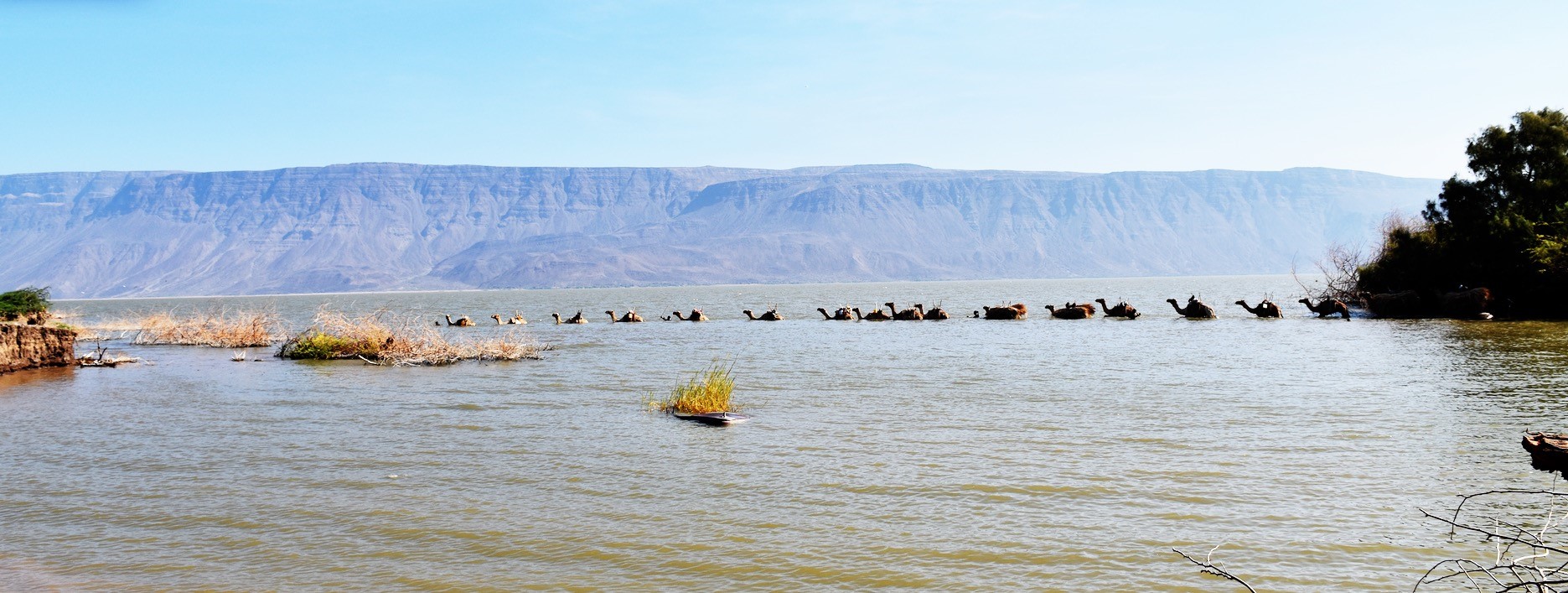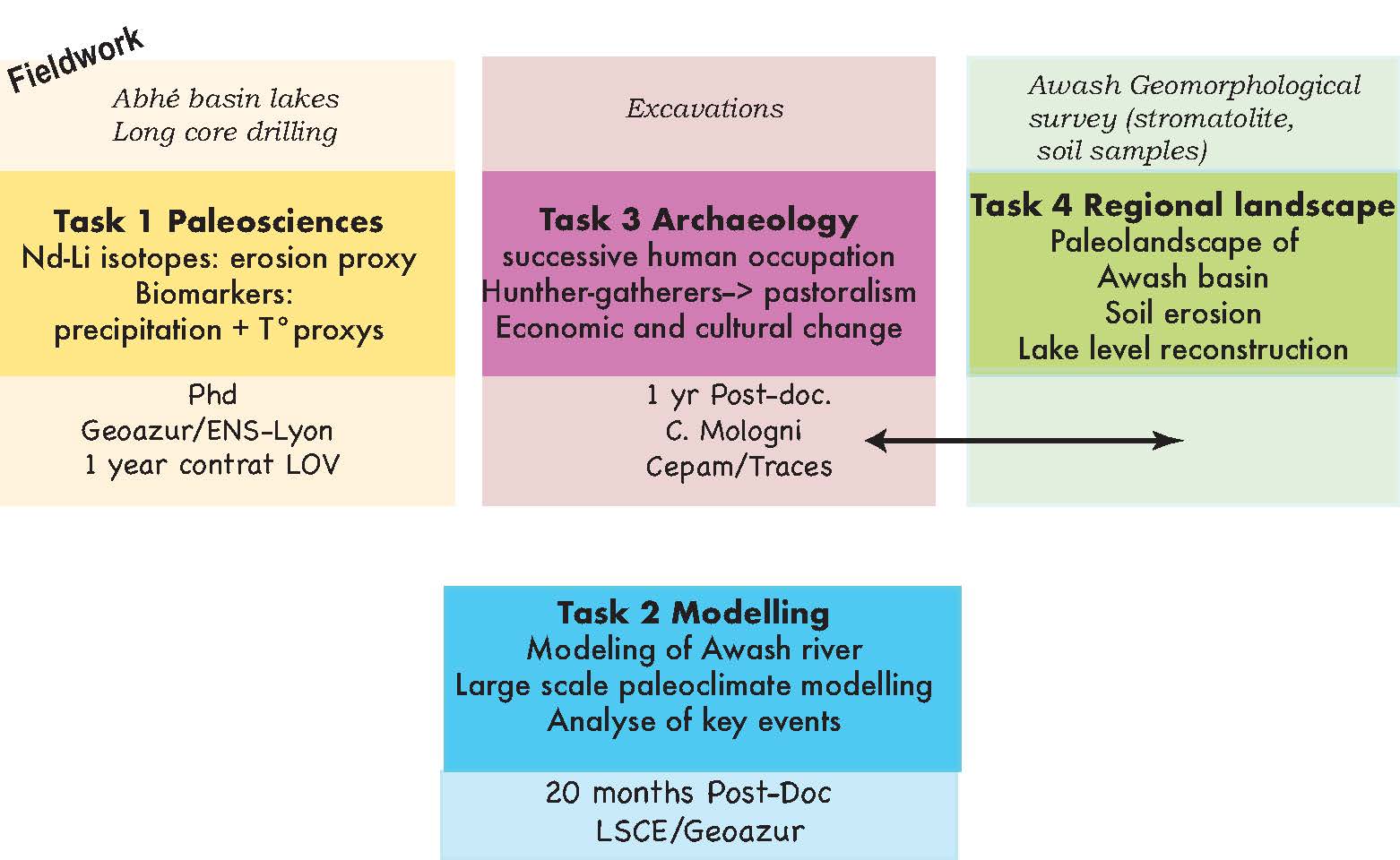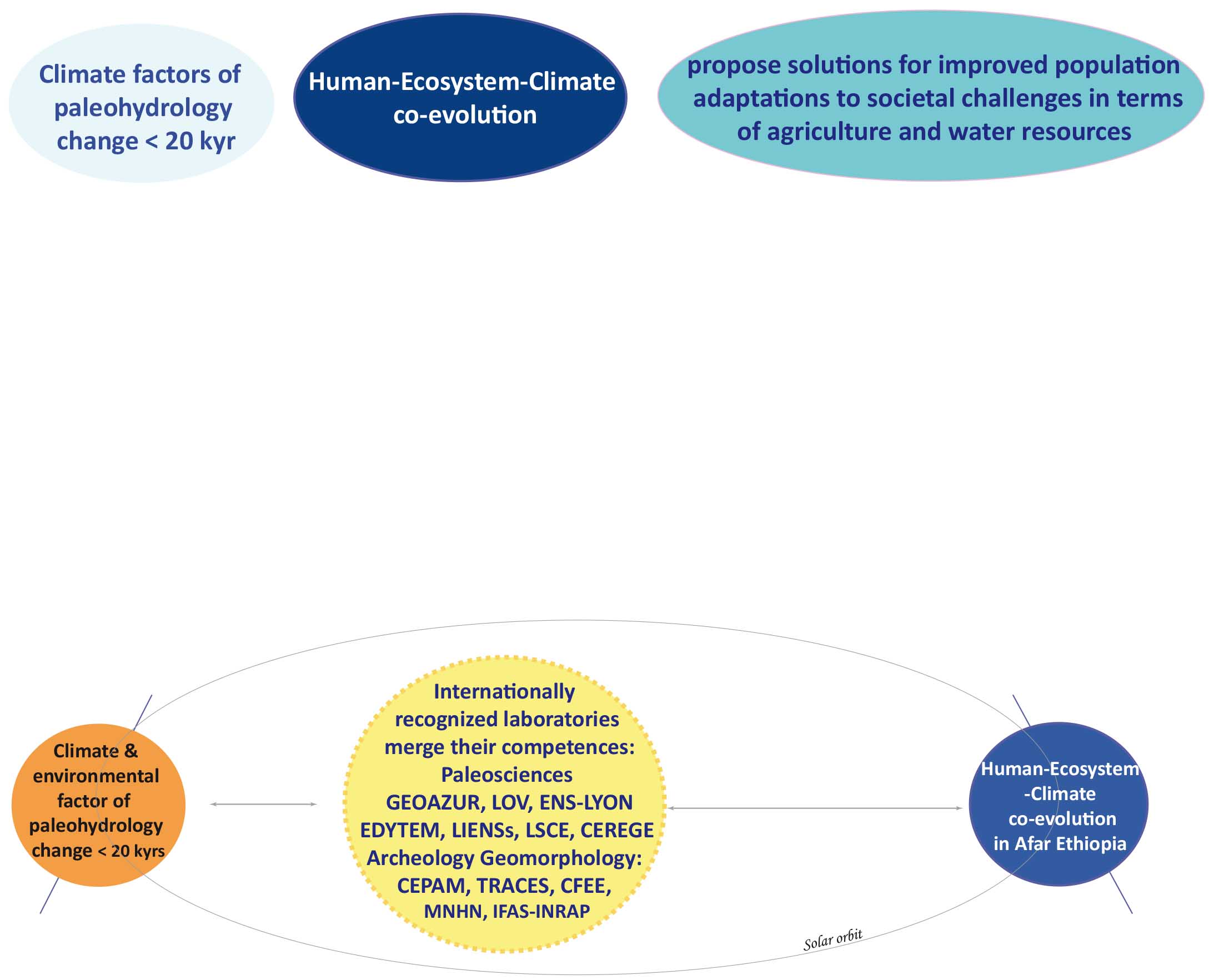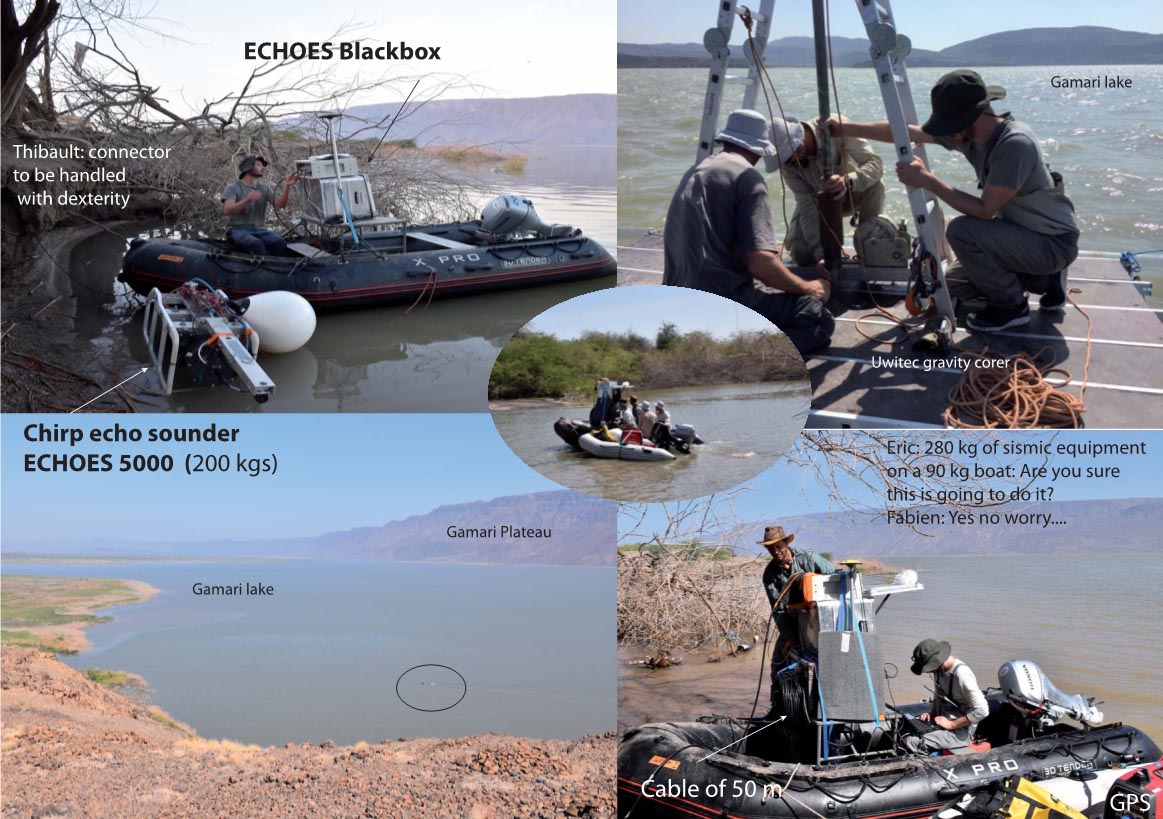Les modèles numériques qui synthétisent nos connaissances du système climatique prévoient pour les décennies à venir des variations extrêmes du cycle de l'eau qui auront un impact sur les ressources naturelles et les populations. Dans la corne de l’Afrique, depuis plusieurs milliers d’années, des périodes de fortes et faibles moussons ont déterminé la disponibilité en eau dans les basses terres, ce qui a affecté drastiquement les dynamiques de peuplement humain. Comment ces populations se sont-elles adaptées à ces changements plus ou moins rapides de disponibilité en eau depuis 20,000 ans ? Comment l’homme s’adaptera aux changements climatiques et environnementaux futurs ?
Model simulations of future climate change predict a reduction of precipitation in subtropical desert zones at the end of the 21st century over the coming decades, which will have an impact on natural resources and populations. In the Horn of Africa, for several thousand years, periods of strong and weak monsoons have determined the availability of water in the lowlands, which has drastically affected the dynamics of human settlement. How have these populations adapted to these more or less rapid changes in water availability over the last 20,000 years? How will humans adapt to future climatic and environmental changes?
Le projet NILAFAR vise à quantifier les fluctuations hydrologiques et à documenter leurs conséquences sur les communautés humaines, à la transition entre le monde des chasseurs-cueilleurs et le monde des agro-pasteurs, au cours des 20,000 dernières années, en Afrique du nord-est (en région Afar, Ethiopie & Djibouti). Il vise aussi à une compréhension fine des mécanismes à l’origine des fluctuations de la mousson africaine et des épisodes d’hyperaridités qui se sont installés en quelques centaines d’années dans le passé.
The NILAFAR project aims to quantify hydrological fluctuations and document their consequences for human communities during the transition from hunter-gatherers to agro-pastoralists over the last 20,000 years in north-east Africa (in the Afar region, Ethiopia and Djibouti). It also aims to better understand of the mechanisms behind fluctuations in the African monsoon and episodes of hyper-aridity that took place over a few hundred years in the past.
--> https://geoazur.oca.eu/fr/anr-nilafar

Lac Gamari (Ethiopie)
Ce projet est conçu sur une synergie disciplinaire et humaine en région Afar entre :
- des missions de terrain en archéologie, paléoclimat (carottage de lac) et géomorphologie
- de la modélisation du climat : échelle régionale (débit du Nil Bleu et de l’Awash) et télé-connection globale
- des analyses en laboratoire afin de i) définir les stratégies de subsistance humaine telles que la pêche, l'élevage et le commerce ii) quantifier les fluctuations hydrologiques et leurs impacts sur l’érosion des sols à partir du couplage de biomarqueurs organiques (d2Hwax), des isotopes du lithium & néodyme et l’étude des diatomées (fonctions de transfert hydro-chimique).
-
This project is based on disciplinary and human synergy in the Afar region between :
- fieldwork in archaeology, palaeoclimate and geomorphology
- climate modelling: regional scale (flow of the Blue Nile, Awash & Gobbad) and global remote sensing
- laboratory analyses in order to i) define human subsistence strategies such as fishing, livestock farming ii) quantify hydrological fluctuations and their impact on soil erosion by coupling organic biomarkers (delta2Hwax), lithium & neodymium isotopes and the study of diatoms (hydro-chemical transfer functions).

Les attendus scientifiques sont :
- Etablir un modèle de peuplement diachronique à grande échelle dans la région Afar
- Mieux comprendre la co-évolution Homme-Ecosystème-Climat depuis 20,000 ans
- A long terme, mieux comprendre la variabilité passée de la mousson en Afrique afin de proposer des tendances hydrologiques futures et in fine aider à améliorer l’adaptation des populations face au défi de la raréfaction des ressources en eau.
-
The scientific objectives are :
- Establish a large-scale diachronic settlement model in the Afar region
- A better understanding of human-environment-climate co-evolution over the last 20,000 years.
- In the long term, a better understanding of past monsoon variability in East Africa in order to propose future hydrological trends and, and thus raise people’s awareness of future changes in ecosystems so that populations can better adapt.

Période de financement : avril 2021- avril 2027 (contact revel@geoazur.unice.fr)
Montant : Aide ANR: 558 684,00 €
Coordinateur du project : Marie Revel (GEOAZUR)
Partners:
Paleosciences
LOV Laboratoire d'océanographie de Villefranche: Nathalie Vigier
LGL-TPE: Laboratoire de géologie de Lyon: Terre, Planètes, environnements : Guillemette Ménot
Archéologie
CEPAM: Cultures et Environnements. Préhistoire, Antiquité, Moyen Age: Lamya Khalidi,
Geomorphologie
TRACES Travaux de Recherches Archéologiques sur les Cultures, les Espaces et les Sociétés: Laurent Bruxelles
--> partenaire de Geoazur
Modélisation
LSCE Laboratoire des Sciences du Climat et de l'Environnement Pascale Braconnot
Collaborateurs : Pierre Brigode & Sébastien Migeon (Géoazur), Pascale Braconnot & Masa Kageyama, Jérémy Jacob (LSCE), Françoise Chalié & Florence Sylvestre (CEREGE), Fabien Arnaud (EDYTEM), Eric Chaumillon (LIENSs), Maryline Montanes (LOV), Jessie Cauliez (TRACES), Gourguen Davtian & Marzia Gabriele (TRACES), Joséphine Lesur (MNHN), François Bon (TRACES), Clément Ménard (CFEE), Louise Purdue (CEPAM), Lucie Coudert (MNHN) et Carlo Mologni (CEPAM)
International collaborations:
CFEE
ARCCH (Ethiopie)
CERD (Djibouti)
IRAH (Djibouti)
Khalidi, L. J. Cauliez, L. Bruxelles, J. Lesur (MNHN) and C. Ménard have extensive experience in archaeological excavations, geoarchaeology and geomorphological surveys in Ethiopia and Djibouti. L. Khalidi currently directs the VAPOR-Afar program in the Ethiopian Afar. J. Cauliez currently directs the PSPCA program in the Djibouti Afar. For the last 10 years, these groups of internationally recognized researchers have worked together in the framework of fieldwork programs and have forged cooperative links with local researchers, students, universities and institutions in the region (Ethiopian Authority for Research and Conservation of Cultural Heritage ARCCH, National Museum of Addis Ababa, Afar Bureau of Tourism and Culture ABTC, Universities of Semara, Addis Ababa and Hawassa)
and Centre d’Etude et de Recherche de Djibouti CERD, Centre Français des Etudes Ethiopiennes CFEE, and the IRAH).
https://anr.fr/Project-ANR-20-CE03-0011

Rapport : Un aperçu de la mission de sismique/carottage en Ethiopie déc. 2018 (CLIMAFAR IDEX UCA)
Biblio:
50-year seasonal variability in East African droughts and floods recorded in central Afar lake sediments (Ethiopia) and their connections with the El Niño-Southern Oscillation.
Mologni C., Revel M., Chaumillon E., Malet E., Coulombier T., Sabatier P., Brigode P., Hervé G., Develle A. L., Schenini L., Messous M., Davtian G., Carré A., Bosch D., Volto N., Ménard C., Khalidi L. & Arnaud F.
Climate of the Past 20(8):1837-1860, 2024
Enhanced continental weathering ( δ 7 Li, ε Nd) during the rise of East African complex polities: an early large-scale anthropogenic forcing?.
Mologni C., Revel M., Bastian L., Bayon G., Bosch D., Khalidi L. & Vigier N.
Comptes Rendus. Géoscience 354(G2):319-337, 2022
9000 years of human lakeside adaptation in the Ethiopian Afar: Fisher-foragers and the first pastoralists in the Lake Abhe basin during the African Humid Period. Khalidi L., Mologni C., Ménard C., Coudert L., Gabriele M., Davtian G., Cauliez J., Lesur J., Bruxelles L., Chesnaux L., Redae B. E., Hainsworth E., Doubre C., Revel. M., Schuster M. & Zazzo A. (2) Quaternary Science Reviews 243:106459, 2020.
Holocene East African monsoonal variations recorded in wave-dominated clastic paleo-shorelines of Lake Abhe, Central Afar region (Ethiopia & Djibouti). Mologni C., Bruxelles L., Schuster M., Davtian G., Ménard C., Orange F., Doubre C.,Cauliez J., Berhane T.H., Revel. M., Khalidi L. 2021. Geomorphology, 391, 2021
Summary ANR NILAFAR :
The NILAFAR program aims to study the impact of hydrological fluctuations on societies at the transitionbetween hunter-gathering and agro-pastoralism in NE Africa over the last 20,000 years. Its objectives are to better understand the mechanisms at the origin of the intensity fluctuations of the African monsoon (external forcing and internal feedbacks of the climate system), and at the origin of episodes of hyperaridity that occurred over a few hundred years.
During these episodes, the Green Sahara, or African Humid Period, saw the retraction or dissemination of particularly mobile human groups. In an environment that may have been as limiting as it was stimulating due to the alternation of these hyperarid and wet phases, populations innovated using new economic strategies, for example by shifting from a predation to a production economy. NILAFAR proposes the quantification of hydrological-monsoon changes (through study of lake & river sediments and hydro-climatic models) to explore the correlation between paleo-hydrological regimes and the evolution of these anthroposystems in progress, in the Afar valley in Ethiopia and Djibouti.
The Green Sahara or African Humid Period, which is characterized by heavier rainfall than today, will been revisited using innovative geochemical and organic tools that allow a quantification of hydrological variations of lakes and chemical alteration of Ethiopian soils at high temporal resolution (~100 years). Lakes Afambo, Gamari and Abhé and their watersheds are chosen for their extreme sensitivity in this area of the Sahel. These lakes contain very high-resolution archives of major monsoon and environmental changes that occurred from the late Pleistocene to the early Holocene. The originality of the project is that it is designed as an interdisciplinary and human collaboration between different fields of study in the Afar region (archaeology, coring of Abhé basin lake sediment, geomorphology, cartography), hydro-climatic modelling and innovative tools (lithium isotopes, biomarkers) and classical analytical tools (neodymium isotopes, study of diatoms and hydrochemical transfer functions).
The establishment of robust age models, both for lake and soil archives and for successive human occupation sequences in the area (using radionuclide and C14 dating) is a priority of this program. In parallel, large-scale climate simulations will be used to study the mechanisms of monsoon change during the last deglaciation/Holocene and a rain-flow model will be developed to better understand the changes in the flow of the Awash River. In the long term, these models will be used to establish future climate and hydrological scenarios for this region.
The benefits of the project will be retro-action by consolidating future scenarios of ecosystem evolution for future populations. By exploring the co-evolution of Man-Ecosystem-Climate over a wide chronological sequence, one of our aims is to propose solutions to better adapt populations to the agricultural and water resource challenges of our societies, of first order in countries such as Ethiopia and Djibouti which are facing infrastructure development. The benefits will also include training students and future researchers to understand global warming and cautiously predict the future of arid regions. This transmission of knowledge will take place over four years through a PhD thesis request for modelling, a request for two post-doctoral students for the acquisition of innovative data, a master's internship in archaeology and field and course training of university students in Ethiopia and Djibouti.




